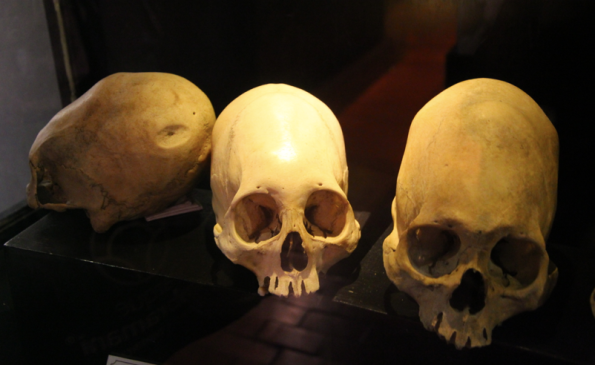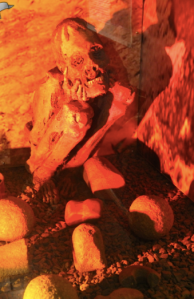Mummies—who knew they were party animals?
This trip, Poor John and I sprang for two Cusco tourist tickets. At 130 soles (about $50) each, they aren’t cheap. But they’re good for 10 days and get you into 16 government-run archaeological or cultural sites in and around the city. So far we’ve hit seven destinations with a couple more must-sees on the list.
The Museo de sitio del Qoricancha is a little gem we visited yesterday afternoon. It’s linked to the Temple of the Sun (Qoricancha), which has a separate admission fee because it is run by the church.
It took us about 20 minutes to cruise through the museum—it helps that all the signs are in Spanish and English. I was pleased to see that the displays confirmed much of the spiel our guide had shared with us over the previous two days.
Take food for instance. The Incas knew how to dehydrate potatoes and beef, and I’m guessing the word for jerky comes from their word ‘charki’.
Skulls are another example. Incas deformed skulls as a way to differentiate the classes and create big/intelligent brains. Most skulls were elongated while others were given a bulge. Mothers and midwives used varying techniques to ‘massage’ the skull into a desired shape—changing dressings as a child grew. The mere thought gives me a headache.
Incan doctors also perform surgery on skulls, usually after an individual had suffered some traumatic injury. Our guide said that a hole chipped into the skull was covered with a gold mesh. If it healed, you lived; otherwise you died.
Which brings me to the mummies.
The museum’s three mummies are accompanied by an explanation of how they lived in death. The description comes from the chronicler Pedro Pizarro. I wanted to use his words verbatim, but the translation is garbled, so here’s a summary.
A lord’s servants were bound by law and custom to mummify their master and to continue to care for him as they did when he was alive.
They dressed him in finery and carted him along to all community events. Mummies ‘ate and drank’ with their servants and were regularly toasted by ministers.
Mummies also went along when the servants visited the homes of others who had mummies present. The view was that the mummies wanted to carry on in death as they had in life.
The bit that tickled me the most is that they ‘would leave the mummies to spend time together’ and always brought them to ‘festivals of drinking and dancing’.
All this makes me wonder whether the art of mummification was truly forgotten, or just plain abandoned because it was considered to be not really worth all the trouble. What do you think?




Museums and customs fascinate me Peggy, true!
I think I would leave my Mummy at home so I did not forget her/him after enjoying a wine or two! lol
Cheers! Joanne
LikeLike
Oh my gosh Joanne, you are absolutely right. Chicha (the corn alcohol here) is lethal and I bet quite a few mummies got left behind after a heavy night. But I don’t suppose people would steal them.
LikeLike
Now I’m feeling a little ripped off. I have no memory of my mother massaging my skull although it’s something I’ve always done with my kids and still do now as they always ask me to along with a back massage. I think I may take up a welding course so I’m ready for my grankiddies 🙂 xoxo
LikeLike
Good thinking Zarinah. I read that some mums tied small tables to each side of a child’s head, so perhaps you need a carpentry course too.
LikeLike